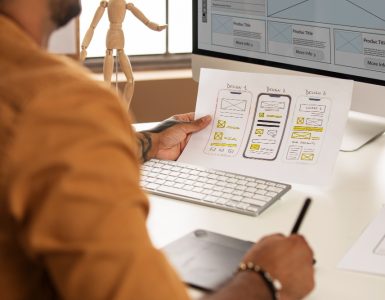Standards in mobile development sometimes change faster than they can be implemented. To stay ahead of the curve, it’s important to focus on the trends, techniques, and approaches that are gaining popularity. I decided to save you time searching to help your business grow faster, and have put together some of the top trends – you need to know about them if you want to pioneer your niche and be head and shoulders above the competition. Today I have highlighted the trends that concern the IT giants and are designed for the mass audience.

1) Mobile Commerce
This trend dominated 2018, 2019 and continued to flourish in 2020. More and more companies are using mobile apps to drive revenue. From large retailers to individual personal brands, apps are helping to make money. Now we are almost at the point where having a mobile app will become a prerequisite for companies to remain competitive in the market.
What Do You Need to Consider?
Mobile traffic will grow, and for your business, a mobile app can be an additional opportunity to grow and increase profits. However, this is not the case for everyone – before deciding to develop a new service, you need to analyze your business goals and needs. In this case, an IT architecture audit can be the starting point to help identify growth areas and create a road map for improvements.
2) Mobile Wallets
Payment methods from mobile devices are also evolving. Mobile wallets such as Apple Pay, Google Pay and Samsung Pay are trending upward. The ongoing pandemic and the proliferation of NFC-enabled devices have spurred the growth of contactless payment in conventional stores. Thus, in October-November this year the share of mobile payment services in the total cash turnover of card transactions has increased to 23% against 18% a year earlier, that is, now about every fourth payment on cards people make through a smartphone. Wallet integration should become a standard feature for every application that processes transactions. And mobile wallet penetration in apps should grow significantly in the coming years.
3) Building Mobile Apps for Internal Use

Increasingly, companies are developing apps for internal use for different purposes:
● business automation (logistics processes, communication and informatization, document management, HR and workflow management, client communication);
● improving the quality, convenience, and speed of employee work (for example, creating file sharing, connecting messengers, social networks, and trackers for internal communication, as well as project and task management systems).
The use of apps can increase the stability of work processes and minimize the number of operational errors. In addition, with the help of mobile services it is possible to quickly increase productivity, which is especially important for actively growing companies. Mobile app development for internal use is needed for large and fast-growing companies that need to automate processes and increase productivity. If your business isn’t focused on scaling, an app won’t do you much good.
4)Motion Design
The trend of introducing elements of motion design into mobile interfaces continues to demonstrate dynamic growth. Users are attracted by the possibility of interactive interaction with web services, and companies are actively using various techniques in app development, for example:
– 3D elements;
– Complex visual effects;
– Background animations;
– Logo animation;
– smooth transitions.
In terms of graphics, designers continue to adhere to minimalism, while using new visual techniques. Among the trends are the use of:
– kinetic typography;
– fine lines;
– fragmented texts;
– morphing;
– isometric design;
– gradients.
These and many other elements will help you display a unique style and entertain the user, improving behavioral factors and boosting the mobile app’s ranking. To increase engagement and improve UI/UX for your mobile app users, try refining it with motion design techniques:
– Guide users through your app with animations that demonstrate which step to take next;
– respond to users’ actions with memorable animations;
– demonstrate the relationship between the different components of the app.
If visuals are important to a business (fashion, accessories, sporting goods), applying new design technologies will be an additional effective way to attract attention.
5) Augmented Reality (AR)
In 2021 augmented reality technologies will continue to develop. Already now, AR functions are increasingly being used in mobile applications for a wide range of tasks and scenarios. For example, augmented reality technology is loved by furniture retailers, household appliances and electronics companies, cosmetic and fashion brands. Using a mobile app, a user can understand in advance what the table in the living room will look like and whether the new refrigerator will fit in the kitchen interior, as well as “try on” a virtual suit and try on new makeup. An example of the use of AR is the Live View feature in Google Maps, which adds clues to real images taken through a smartphone camera and helps users better navigate routes. AR can also be used in training apps and for web-based graphical content creation services (similar to face filters in Instagram and Snapchat).
AR technology has a huge number of possibilities for applications in different areas, and it also works well on the most massively wearable device – the smartphone. However, to develop a quality mobile app with AR, you not only need to define your business goals precisely, but also create good content (animations, realistic 3D and 2D models), which is why it is so important to find experienced IT professionals who can offer a non-template solution.
Thus, the mobile app is not a parasitic sales channel. It is a separate self-sufficient channel for interaction with customers, which, on the one hand, requires separate elaboration, but, on the other hand, should be integrated into the company’s overall development strategy. In order to unite and build a single effective strategy, companies can seek help from experts to reach the next level.
























